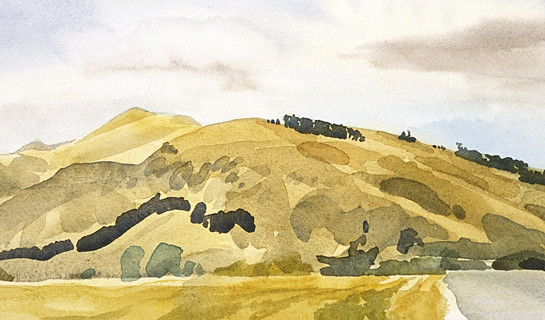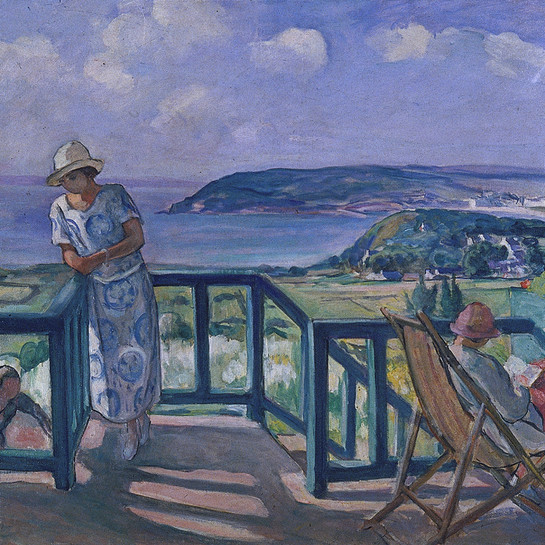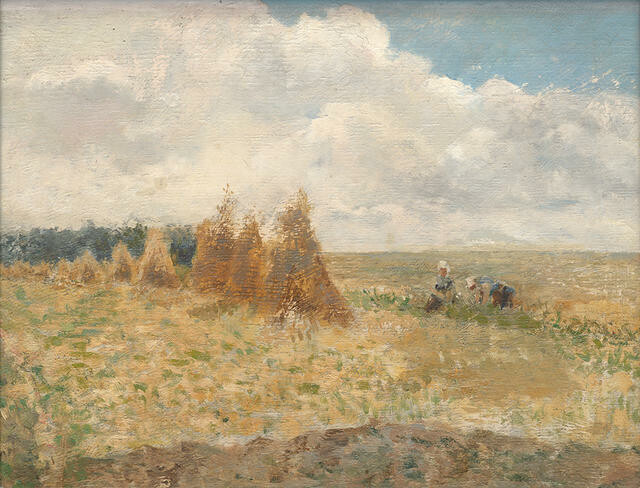Eugène J. Boudin
France, b.1824, d.1898
Cornfield
- c. 1880
- Oil on wood panel
- Presented by the family of James Jamieson 1932
- 480 x 565 x 50mm
- 69/469
Tags: clouds, farms, headscarves, Impressionist (style), landscapes (representations), people (agents), plein-air, women (female humans), workers
Eugène Boudin, the son of a ship’s captain, was born in Honfleur on the Normandy coast, France, and moved at an early age to Le Havre. There he opened a framing shop in 1844, and began showing the work of painters including Jean-François Millet, who encouraged his early efforts in painting. Boudin first visited Paris in 1847; in 1851 he won a scholarship that allowed him three years’ study in Paris before returning to Le Havre. Boudin became one of the first French landscape painters to paint en plein air (in the open air), an approach then regarded as a novelty, and that increased after his visits to Brittany in 1855 and 1857. In 1858, he met eighteen-year-old Claude Monet, then a caricaturist, and persuaded him to take up landscape painting. Monet worked alongside his mentor, and paintings by both were included in an exhibition in Le Havre later that summer. Boudin is recognised as a forerunner of the Impressionists, and was included in their first exhibition in Paris in 1874.
(The Weight of Sunlight, 16 September 2017 - 16 September 2018)
Exhibition History
Nature's Own Voice, 6 February - 26 July 2009
Eugène Boudin was an important figure in promoting plein-air painting in France during the 1860s, introducing the famous Impressionist, Claude Monet to painting outdoors. He was highly regarded by the French Impressionists and contributed work to the first Impressionist exhibition in 1874. 'Cornfield' reveals Boudin’s use of lively direct brushwork to capture his impressions of the colours and textures of the sun drenched fields.
A strong advocate for painting directly from nature, Boudin captures the sense of the open air and direct sunlight on the French cornfield. With direct, visible brushwork he captures the impressions of the colours and textures of the landscape. Boudin would have been using the newly invented tubes of paint which artists could take outdoors with them to work quickly and directly from nature. That explains the small size of this work. The relative casualness in the composition with the shadow in the foreground suggesting features falling just beyond the scope of the chosen view, suggests the photographic image, which was also influential at this time. However, the treatment of the billowing cloud and the careful composition display the hand and eye of an experienced painter.
With this painting of French peasant women gathering bundles of corn to put into stooks, Eugène Boudin achieves an unsentimental record of everyday rural life. He has painted Cornfield in a loose manner, capturing the effects and impressions of light on the field. Boudin was one of a group of painters who influenced the Impressionists.
Born in Honfleur, on the coast of Normandy, Boudin was the son of a harbour pilot. At age 18 he had his own stationery and picture-framing store in Le Havre and included Jean-Francois Millet(1814 -1875) among his customers. In 1851 Boudin moved to Paris to study art. He returned to Le Havre in 1854. There he became something of a mentor to Claude Monet (1840 -1926). Boudin first exhibited at the Paris Salon in 1859 and exhibited at the first 'Impressionist Exhibition' in 1874. He was awarded a gold medal at the 'Exposition Universelle' in 1889. Boudin was awarded the Legion of Honour in 1892.
(Permanent Collection, 2003)




